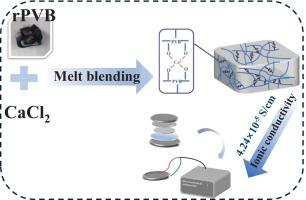Reversible Ca2+ coordination crosslinking of rPVB via melt blending: Concurrent enhancement of thermo-mechanical properties, shape memory effects, and ionic conductivity
IF 5.1
3区 工程技术
Q1 CHEMISTRY, APPLIED
引用次数: 0
Abstract
To address global resource waste and environmental pollution from unrecycled poly(vinyl butyral) (rPVB), this study establishes an rPVB/CaCl₂·nH₂O coordination crosslinking system via melt blending. The regulation mechanism of crosslinking networks on material properties was systematically investigated using multiple techniques including torque rheometry, ATR-IR, DSC, DMA, rheometry, and EIS. The results show that the addition of CaCl₂·nH₂O significantly improves the storage modulus, glass transition temperature (Tg), and mechanical properties of rPVB by forming coordination bonds between PVB hydroxyl groups and Ca2+. When the content of CaCl₂·nH₂O is 10 wt%, the shape fixing rate (Rf) and recovery rate (Rr) of the film both exceed 93 %, demonstrating excellent shape memory performance. In addition, the ionic conductivity of the crosslinked material increases with the increase of CaCl₂·nH₂O content, with a maximum value of 4.24 × 10−5 S/cm. The study confirms that CaCl₂ coordination crosslinking is an effective strategy to regulate the multifunctional properties of rPVB, providing theoretical and technical support for its low-cost applications in intelligent materials, energy storage, and other fields.

通过熔体共混的rPVB可逆Ca2+配位交联:热机械性能、形状记忆效应和离子电导率的同步增强
为解决未回收聚乙烯醇(rPVB)造成的全球资源浪费和环境污染问题,本研究通过熔融共混建立了rPVB/CaCl₂·nH₂O配位交联体系。采用扭矩流变学、ATR-IR、DSC、DMA、流变学和EIS等多种技术系统研究了交联网络对材料性能的调节机理。结果表明,CaCl₂·nH₂O的加入通过在PVB羟基与Ca2+之间形成配位键,显著提高了rPVB的储存模量、玻璃化转变温度(Tg)和力学性能。当cacl2·nh2o含量为10 wt%时,膜的形状固定率(Rf)和恢复率(Rr)均超过93%,表现出优异的形状记忆性能。此外,交联材料的离子电导率随cacl2·nH₂O含量的增加而增大,其最大值为4.24 × 10−5 S/cm。研究证实了cacl2配位交联是调控rPVB多功能特性的有效策略,为其在智能材料、储能等领域的低成本应用提供了理论和技术支持。
本文章由计算机程序翻译,如有差异,请以英文原文为准。
求助全文
约1分钟内获得全文
求助全文
来源期刊

Reactive & Functional Polymers
工程技术-高分子科学
CiteScore
8.90
自引率
5.90%
发文量
259
审稿时长
27 days
期刊介绍:
Reactive & Functional Polymers provides a forum to disseminate original ideas, concepts and developments in the science and technology of polymers with functional groups, which impart specific chemical reactivity or physical, chemical, structural, biological, and pharmacological functionality. The scope covers organic polymers, acting for instance as reagents, catalysts, templates, ion-exchangers, selective sorbents, chelating or antimicrobial agents, drug carriers, sensors, membranes, and hydrogels. This also includes reactive cross-linkable prepolymers and high-performance thermosetting polymers, natural or degradable polymers, conducting polymers, and porous polymers.
Original research articles must contain thorough molecular and material characterization data on synthesis of the above polymers in combination with their applications. Applications include but are not limited to catalysis, water or effluent treatment, separations and recovery, electronics and information storage, energy conversion, encapsulation, or adhesion.
 求助内容:
求助内容: 应助结果提醒方式:
应助结果提醒方式:


